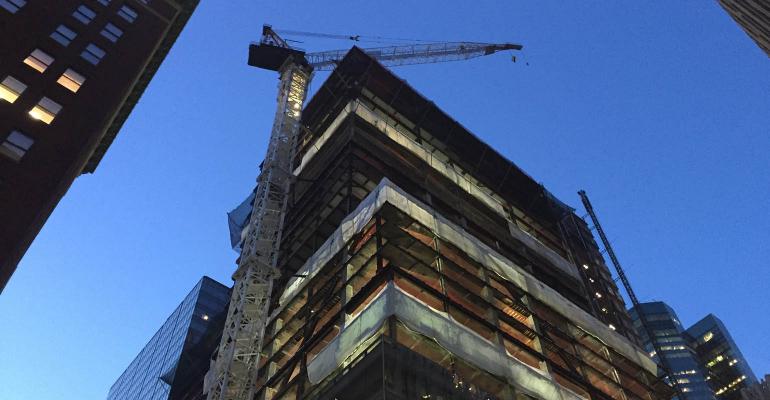The U.S. office market has gained a lot of momentum over the last eight years, with many markets now reporting low vacancies and record-high rents. The bottom line for investors, however, is each market’s value in terms of return on investment (ROI) relative to pricing.
To help investors make informed decisions, a new report from Situs RERC, a global research and advisory firm, analyzed U.S. primary, secondary and tertiary office markets based on second quarter property performance stats, growth, demand markers and other criteria and ranked them on a value vs. price index.
Noting that office is a more volatile product type than multifamily or industrial, Situs RERC President Ken Riggs says, “On the demand side, office fundamentals look good, but on the supply side office markets are measured by whether banks are willing to give developers money to do projects.”
Riggs points out that banks are mostly passing on speculative development right now, but speculative projects still continued in some of Sitrus RERC’s top markets.
For example, Dallas, which topped the ranking for primary markets, has eight speculative buildings with a total of 1.7 million sq. ft. under construction, as does Seattle, with nearly 5 million sq. ft. of speculative development underway.
“Dallas’ strongest positive is it’s an attractive market to relocate,” Riggs says, pointing out that the region’s strong office performance reflects its diverse, growing economy. More than 2.6 million sq. ft. of office space has been absorbed so far this year, according to a second quarter 2017 report from real estate services firm JLL. Office rents rose 5.4 percent year-over-year in the second quarter in all submarkets, and about half of the office space under construction (7.8 million sq. ft.) is pre-leased.
Seattle came in second out of 10 primary markets, with office performance reflecting strong demand by both large and small technology firms. “Seattle’s tech factor has been over-estimated in the short-term and the impact of what will happen under-estimated in the long-term,” Riggs says.
Similar to what happens in the life sciences sector, accumulation of tech companies in one location creates industry hubs that serve as magnets for more companies attracted by the concentration of talent. That’s what’s happening in Seattle, where users have absorbed nearly 2.9 million sq. ft. of space so far this year, nearly twice as much as during the same period in 2016, according to JLL. Class-A vacancy dropped 90 basis points, and rents rose 4.1 percent. Overall office vacancy in the city averaged 8.5 percent, and average asking rent is $35.60 per sq. ft.
Large users are leasing whole buildings in Seattle’s urban core, making it difficult for smaller tenants to find space, notes the JLL report. Three office buildings delivered in the second quarter of this year are now fully rented, and a 12-story, 660,000-sq.-ft. office tower that recently broke ground has been preleased by Google. F5 Networks took all 516,000 sq. ft. at The Mark, renamed 5F Tower. Of the nearly 6 million sq. ft. of space under construction, 47 percent is already committed, and the remaining space is expected to lease up quickly, according to JLL.
Los Angeles ranked third among primary office markets.
“Downtown Los Angeles has been under-rated for too long,” Riggs says. “Downtown has become much more attractive compared to the past and is very inexpensive from a value perspective,” he adds, noting that office assets are selling in downtown for one third what it costs to buy assets in other major cities. While technology tenants continue to drive rents and values up on the Westside, downtown is Los Angeles is still a bargain. An office building in Santa Monica, for example, sold in the second quarter for more than $1,400 per sq. ft., while a downtown asset traded for $470 per sq. ft.
Office users in the city’s Central Business District (CBD) absorbed 433,563 sq. ft. of space in the second quarter, while tenants throughout the Los Angeles metro absorbed nearly 2.2 million sq. ft., according to a report from real estate services firm Cushman & Wakefield. Vacancy in the CBD was 19.4 percent and in the overall metro 12.9 percent. Asking rents average $41.97 per sq. ft. and $41.93 per sq. ft., respectively.
High competition and aggressive cap rates in the primary markets are driving investors to the secondary and tertiary markets for higher yields, Situs RERC researchers point out, noting that these markets also offer greater diversification.
Tampa and Orlando in Florida and Raleigh, N.C. topped secondary metro rankings from a relative value vs. price perspective. All three markets have exceptional job growth, positive office space absorption, rising rents and tightening vacancy, with limited or no new office construction.
While tertiary markets do not provide the scale of primary and secondary markets, the Situs RERC report notes they are not as saturated as bigger metros and provide investors with low barriers to entry. Tucson, Ariz., Columbus, Ohio and Milwaukee, Wis. earned the top three places in the ranking for tertiary markets, respectively. All three markets have good job and wage growth, experienced positive absorption and have low vacancies with limited new product under construction.

